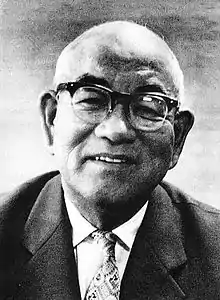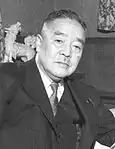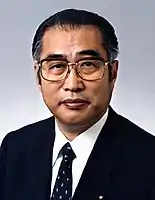Chief Cabinet Secretary
The Chief Cabinet Secretary of Japan (内閣官房長官, Naikaku-kanbō-chōkan) is a Minister of State who is responsible for directing the Cabinet Secretariat of Japan.[1] The main function of the Chief Cabinet Secretary is to coordinate the policies of ministries and agencies in the executive branch.[2] The Chief Cabinet Secretary serves as the government's press secretary,[3] conducts policy research,[4] prepares materials to be discussed at cabinet meetings,[5] and, in time of national crisis, coordinates ministries and agencies of the executive branch.[6] The Chief Cabinet Secretary is customarily nominated as the first in line to serve as temporary Acting Prime Minister in case the Prime Minister is unable to serve due to death or other grave reasons until a new Prime Minister is appointed.[7] The Chief Cabinet Secretary's office is located on the fifth floor of the Prime Minister's official residence in Tokyo.
| Chief Cabinet Secretary of Japan 内閣官房長官 Naikaku-kanbō-chōkan | |
|---|---|
 Emblem of the Government of Japan | |
| Appointer | The Prime Minister |
| Formation | 3 May 1947 |
In March 1879, the forerunner of the position, the Cabinet Secretary was created. From 1885, it was included as part of the cabinet system, and the position was known in Japanese as 内閣書記官長 (naikaku-shokikan-chō), literally "Secretary-General of the Cabinet". The modern position was created on May 3, 1947, shortly after the passage of the Constitution of Japan, and elevated to ministerial status in 1966.
Since 1947, the office of Chief Cabinet Secretary has been regarded as a stepping stone to the post of Prime Minister. The first Chief Cabinet Secretary to become Prime Minister was Ichirō Hatoyama, formerly Chief Cabinet Secretary to Tanaka Giichi. Since then, eight other former Chief Cabinet Secretaries have become Prime Ministers, most recently Shinzō Abe, Yasuo Fukuda, and Yoshihide Suga.
Suga, who served under Shinzō Abe for eight years, is the longest-serving Chief Cabinet Secretary in history, having overtaken the previous record of 1,289 days in office set by Fukuda on July 7, 2016.[8] Suga was replaced by Katsunobu Katō, who was the outgoing health minister.[9]

List of Secretary-Generals of the Cabinet
Shōwa Era
- Tsukamoto Kiyoji (December 25, 1926–April 20, 1927)
- Ichirō Hatoyama (April 20, 1927–July 2, 1929)
- 6 other holders (July 3, 1929–October 19, 1934)
- Shigeru Yoshida (October 20, 1934–May 11, 1935) - not to be confused with PM Shigeru Yoshida.
- 14 other holders (May 12, 1935–April 6, 1945)
- Hisatsune Sakomizu (7 April 1945–15 August 1945)
- vacant (August 16, 1945–October 9, 1945)
- Daizaburō Tsugita (October 9, 1945–January 13, 1946)
- Wataru Narahashi (January 13, 1946–May 22, 1946)
- Jyōji Hayashi (May 22, 1946–May 2, 1947)
List of Chief Cabinet Secretaries
Shōwa Era
Liberal (1945)
Socialist
Democratic (1947)
Democratic Liberal
Liberal (1950)
Democratic (1954)
Liberal Democratic
| Chief Cabinet Secretary | Term of office | Prime Minister | |||||
|---|---|---|---|---|---|---|---|
| Portrait | Name | Took Office | Left Office | Days | |||
 |
Jōji Hayashi | May 3, 1947 | May 24, 1947 | 21 | Shigeru Yoshida | ||
 |
Suehiro Nishio | June 1, 1947 | March 10, 1948 | 283 | Tetsu Katayama | ||
 |
Gizō Tomabechi | March 10, 1948 | October 15, 1948 | 219 | Hitoshi Ashida | ||
 |
Eisaku Satō[n 1] | October 17, 1948 | February 16, 1949 | 122 | Shigeru Yoshida | ||
 |
Kaneshichi Masuda | February 16, 1949 | May 6, 1950 | 444 | |||
 |
Katsuo Okazaki | May 6, 1950 | December 26, 1951 | 599 | |||
 |
Shigeru Hori | December 26, 1951 | October 30, 1952 | 309 | |||
 |
Taketora Ogata | October 30, 1952 | May 21, 1953 | 203 | |||
 |
Kenji Fukunaga | May 21, 1953 | December 10, 1954 | 568 | |||
 |
Ryutarō Nemoto | December 10, 1954 | November 22, 1955 | 744 | Ichirō Hatoyama | ||
| November 22, 1955 | December 23, 1956 | ||||||
 |
Hirohide Ishida | December 12, 1956 | July 10, 1957 | 210 | Tanzan Ishibashi | ||
| Nobusuke Kishi | |||||||
 |
Kiichi Aichi | July 10, 1957 | June 12, 1958 | 337 | |||
 |
Munenori Akagi | June 12, 1958 | June 18, 1959 | 371 | |||
 |
Etsusaburō Shiina | June 18, 1959 | July 19, 1960 | 397 | |||
 |
Masayoshi Ōhira[n 2] | July 19, 1960 | July 18, 1962 | 729 | Hayato Ikeda | ||
 |
Yasumi Kurogane | July 18, 1962 | July 18, 1964 | 731 | |||
 |
Zenkō Suzuki[n 3] | July 18, 1964 | November 9, 1964 | 114 | |||
 |
Tomisaburō Hashimoto | November 9, 1964 | August 1, 1966 | 630 | Eisaku Satō | ||
 |
Kiichi Aichi | August 1, 1966 | December 3, 1966 | 124 | |||
 |
Kenji Fukunaga | December 3, 1966 | June 22, 1967 | 201 | |||
 |
Toshio Kimura | June 22, 1967 | November 30, 1968 | 527 | |||
 |
Shigeru Hori | November 30, 1968 | July 5, 1971 | 947 | |||
 |
Noboru Takeshita[n 4] | July 5, 1971 | July 7, 1972 | 368 | |||
 |
Susumu Nikaidō | July 7, 1972 | November 11, 1974 | 857 | Kakuei Tanaka | ||
 |
Noboru Takeshita[n 4] | November 11, 1974 | December 9, 1974 | 28 | |||
 |
Ichitarō Ide | December 9, 1974 | December 24, 1976 | 746 | Takeo Miki | ||
.jpg.webp) |
Sunao Sonoda | December 24, 1976 | November 28, 1977 | 339 | Takeo Fukuda | ||
 |
Shintaro Abe | November 28, 1977 | December 7, 1978 | 374 | |||
 |
Rokusuke Tanaka | December 7, 1978 | November 9, 1979 | 337 | Masayoshi Ōhira | ||
 |
Masayoshi Ito[n 5] | November 9, 1979 | July 17, 1980 | 251 | |||
| Himself (Acting) | |||||||
 |
Kiichi Miyazawa[n 6] | July 17, 1980 | November 27, 1982 | 863 | Zenkō Suzuki | ||
 |
Masaharu Gotōda | November 27, 1982 | December 27, 1983 | 395 | Yasuhiro Nakasone | ||
 |
Takao Fujinami | December 27, 1983 | December 28, 1985 | 732 | |||
 |
Masaharu Gotōda | December 28, 1985 | November 6, 1987 | 678 | |||
 |
Keizō Obuchi[n 7] | November 6, 1987 | January 7, 1989 | 428 | Noboru Takeshita | ||
Heisei Era
Liberal Democratic
Japan New Party
New Party Sakigake
Japan Renewal Party
Socialist
Democratic
| Chief Cabinet Secretary | Term of office | Prime Minister | |||||
|---|---|---|---|---|---|---|---|
| Portrait | Name | Took Office | Left Office | Days | |||
 |
Keizō Obuchi[n 7] | January 8, 1989 | June 3, 1989 | 147 | Noboru Takeshita | ||
 |
Masajuro Shiokawa | June 3, 1989 | August 10, 1989 | 68 | Sōsuke Uno | ||
 |
Tokuo Yamashita | August 10, 1989 | August 26, 1989 | 16 | Toshiki Kaifu | ||
 |
Mayumi Moriyama | August 26, 1989 | February 28, 1990 | 186 | |||
 |
Misoji Sakamoto | February 28, 1990 | November 5, 1991 | 615 | |||
 |
Koichi Kato | November 5, 1991 | December 12, 1992 | 403 | Kiichi Miyazawa | ||
 |
Yōhei Kōno | December 12, 1992 | August 9, 1993 | 240 | |||
 |
Masayoshi Takemura | August 9, 1993 | April 28, 1994 | 262 | Morihiro Hosokawa | ||
 |
Hiroshi Kumagai | April 28, 1994 | June 30, 1994 | 63 | Tsutomu Hata | ||
 |
Kozo Igarashi | June 30, 1994 | August 8, 1995 | 404 | Tomiichi Murayama | ||
 |
Koken Nosaka | August 8, 1995 | January 11, 1996 | 156 | |||
 |
Seiroku Kajiyama | January 11, 1996 | September 11, 1997 | 609 | Ryutaro Hashimoto | ||
 |
Kanezo Muraoka | September 11, 1997 | July 30, 1998 | 322 | |||
 |
Hiromu Nonaka | July 30, 1998 | October 10, 1999 | 432 | Keizo Obuchi | ||
 |
Mikio Aoki | October 10, 1999 | July 4, 2000 | 273 | |||
| Yoshiro Mori | |||||||
 |
Hidenao Nakagawa | July 4, 2000 | October 27, 2000 | 115 | |||
.png.webp) |
Yasuo Fukuda[n 8] | October 27, 2000 | May 7, 2004 | 1380 | |||
| Junichiro Koizumi | |||||||
 |
Hiroyuki Hosoda | May 7, 2004 | October 31, 2005 | 450 | |||
 |
Shinzō Abe[n 9] | October 31, 2005 | September 26, 2006 | 330 | |||
 |
Yasuhisa Shiozaki | September 26, 2006 | August 27, 2007 | 335 | Shinzō Abe | ||
 |
Kaoru Yosano | August 27, 2007 | September 26, 2007 | 30 | |||
 |
Nobutaka Machimura | September 26, 2007 | September 24, 2008 | 364 | Yasuo Fukuda | ||
 |
Takeo Kawamura | September 24, 2008 | September 16, 2009 | 357 | Taro Aso | ||
 |
Hirofumi Hirano | September 16, 2009 | June 8, 2010 | 265 | Yukio Hatoyama | ||
 |
Yoshito Sengoku | June 8, 2010 | January 4, 2011 | 210 | Naoto Kan | ||
 |
Yukio Edano | January 4, 2011 | September 2, 2011 | 241 | |||
 |
Osamu Fujimura | September 2, 2011 | December 26, 2012 | 481 | Yoshihiko Noda | ||
 |
Yoshihide Suga | December 26, 2012 | April 30, 2019 | 2316 | Shinzō Abe | ||
Reiwa Era
| Chief Cabinet Secretary | Term of office | Prime Minister | |||||
|---|---|---|---|---|---|---|---|
| Portrait | Name | Took Office | Left Office | Days | |||
 |
Yoshihide Suga | May 1, 2019 | September 16, 2020 | 504 | Shinzō Abe | ||
 |
Katsunobu Katō | September 16, 2020 | Incumbent | 137 | Yoshihide Suga | ||
See also
Notes
- Later served as Prime Minister 1964-72
- Later served as Prime Minister 1978-80
- Later served as Prime Minister 1980-82
- Later served as Prime Minister 1987-89
- Served as Acting Prime Minister on the death of Ōhira, 12 June - 17 July 1980
- Later served as Prime Minister 1991-93
- Later served as Prime Minister 1998-2000
- Later served as Prime Minister 2007-08.
- Later served as Prime Minister 2006-07, 2012-present.
References
- Footnotes
- Cabinet Act, Article 13.
- Cabinet Act, Article 12, Paragraph 2, Item 4 and 5
- Cabinet Act, Article 17
- Cabinet Act, Article 12, Paragraph 2, Item 6
- Cabinet Act, Article 12, Paragraph 2, Item 1
- Cabinet Act, Article 15
- Cabinet Act, Article 9
- "Government strongman Suga set to become Japan's longest-serving chief Cabinet secretary". Japan Times. Jiji Press. Retrieved 3 December 2016.
- Sugiyama, Satoshi (2020-09-16). "Suga takes the reins as Japan's new prime minister, replacing Abe". The Japan Times. Retrieved 2020-09-17.
- Notes

